Alan Bahr's Blog
April 11, 2023
Worldbuilding: Seven Ribbon Village
Worldbuilding is a series of articles where I’m stretching my legs and attempting to define and write a really detailed setting (starting small and getting larger) in an effort to grow as a writer and designer.
It’s difficult. I like things that are difficult. Eventually, I’d love to turn these into a zine series that builds a setting over time, but I’m going to fail in public first!
Seven Ribbon Village
All this content is (C) Northern Lights Foundry. 2023.
Deep in the valleys and cliffs of the Westland Frontier is a quiet, unassuming village, where some of the world’s greatest swordmasters come from.
A population of a few thousand belays the importance of the martial traditions of this village, and their ties to the deep history of the world around you.
While Seven Ribbon Village is not its true name, it is how nearly everyone in the world at large refers to the home of these swordmasters.
HistoryAccording to the lore and stories of Seven Ribbon Village, the founders of the village were the last of the exiled royal line of Antariav, banished into the Westland Frontier, where they founded a rural settlement, eking out a meager existence while keeping the traditions of the nobility of Imperial Antari alive.
TraditionsAll those raised in Seven Ribbon Village follow particular traditions and cultural rules, derived from the long extinct martial traditions of the royalty of Antariav. While long forgotten after the Imperial Antari fell, these traditions have grown and adjusted to encompass all of Seven Ribbon Village.
All those born and raised in the village receive nominal training in the art of swordsmithing, swordplay, and culture. While none are pressured to become swordbearers, nearly everyone from Seven Ribbon Village is at least capable of defending themselves, as well as maintaining and caring for bladed weapons.
The Weight of a SwordThe most important cultural facet and taboo of Seven Ribbon Village is the prohibition against using any belt, tool, or device to hoist or carry a sword. This is considered to be an immutable rule, and those who break it are disdained by the village, or even exiled.
A long-standing religious belief regarding implements of death in Imperial Antari, the tradition has now morphed to one of ethics and commitment. As the stories and training in Seven Ribbon Village explain it: “If you are willing to carry a sword and take life, you must be willing to be reminded of the weight at all times. To carry death in your hand is a heavy burden.”
Those in Seven Ribbon Village take this ethos seriously, and all those who are committed to swordplay adhere to it. Generally, swords made in seven ribbon village are straight and thin, as their sword techniques focus on speed and precision, in order to avoid weighing down the swordbearers, who often fight with their scabbard and its metal rings in one hand, and their sword in the other (the metal rings in the scabbard are excellent for defensive blocking).
Ribbons and RanksAll swordbearers in the village gain a red ribbon on their coming of age, which is tied through a ring on the pommel of the sword.
When a swordbearer defeats an opponent who has a ribbon of a higher rank, they tie that color ribbon through one of the seven rings on their scabbard. As the colors ascend, so does their title and reputation in Seven Ribbon Village.
Colors
Red
White
Green
Grey
Yellow
Purple
Blue
Titles
Initiate
Practitioner
Warrior
Knight
Paladin
Master
Immortal
Architecture and BuildingsMost of the homes in Seven Ribbon Village are squat, simple affairs, crafted out of stone foundations, with wooden walls and roofs. The village is arranged in the manner of the long buried and forgotten Imperial Palace, with a large stone "gathering hall” at the center, seven streets extending from it to the village edges, and each section of the “pie” being cut by three circular rings. However, the lessons of the fall of Antariav carry deep wounds that have been reflected in how the village has been arranged over the centuries.

Each of the outer ring sections are devoted to smithies, stables, mills, and other tasks that are required to keep the village functioning and moving forward. These buildings are designed to be shuttered and rendered into killing fields, with thick walls to resist fire and attacks, as well as confusing roads and alleys designed to disorient attackers.
The inner ring is where houses, living quarters, and other spaces that need to be protected lie. Easy to understand alleys and routes funnel to the stone gathering hall, where the hall can serve as an easily defensible fortress, with cellars full of food, supplies, and weapons are kept. Hidden tunnels from the center gathering hall exit out into the hills surrounding the town, allowing for escape or flanking maneuvers against enemies.
PoliticsOne might expect the village to be ruled by the best swordbearer, but martial might does not govern Seven Ribbon Village. Instead, the village is overseen by a council of elders, descended from the royal line of Antariav, and who only hold the rank of red. Those who engage in conflict might seek to use their power against the good of the village, and as such, only those who must rely on the people for their power are able to lead.
It’s a precarious system of checks and balances, but the collective history of the village has led to this unusual system working. A swordbearer would not dream of trying to usurp the council, and if one did, they’d find nearly all of Seven Ribbon Village arrayed against them. Likewise, councilmembers who seek only to profit themselves have little to stand on, as swordbearers won’t protect them, and the rest of the council would swiftly eject them.
Food & DrinkSeven Ribbon Village is rural, and as such, feeds themselves mostly on grains, fruit grown in local orchards, and livestock (mostly goats and sheep). Alcohol is strictly regulated in the village (a necessity in a place full of exceptional combatants), and only really used in ceremonial or celebratory circumstances.
Of note, the famous jalia-tuv blackbread is made from unique hardy roots and grains that are grown in the hills surrounding the village. This bread is exceptionally filling, healthy, easy to make, dense but light to carry, and holds its quality for weeks on end. It is a favorite of travelers, wanderings and soldiers, and merchants will often arrive at Seven Ribbon Village to secure grain and roots for export so the bread can be made in further afield in other places.
Of course, it is never quite as good as it is from the bakeries of Seven Ribbon Village.
March 22, 2023
Of Iron, Salt & Wood
Shot & Splinter is really good. Find it here or on DTRPG.
We did our first session of it last night, after some warm up. I’d gone to a local print shop to have a binder copy of printed for easy reference for me as we played, as well as getting the first hex map laminated.
I adore Age of Sail genre games (especially in RPGs, but pretty much any medium), and I was pretty excited to play.
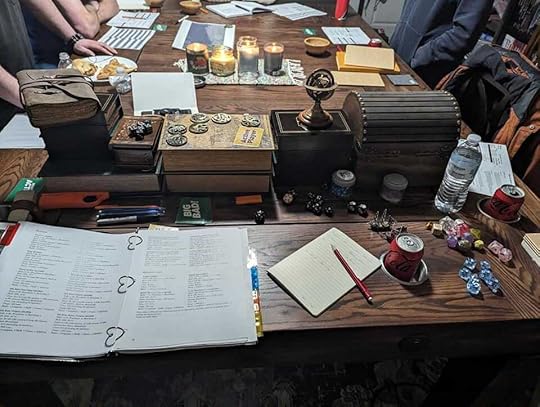
It was a blast. Every piece of the game fired perfect. The ship mate generation lead us to some wonderfully ship characters, the ship to ship combat was brutal and unforgiving, as well as tense (the ship lost one of their favorite NPCs almost immediately, which really unscored the tension), and character generation was a snap.
I’d set up a playlist, I had a mix of candles (some custom made, some bought) to create a salt-water, lumber and sawdust, and smoke/tobacco scent to the room, and I’d prepared custom character sheets to keep things moving (I am *not* a fancy character sheet creator, but they worked), and we were off!
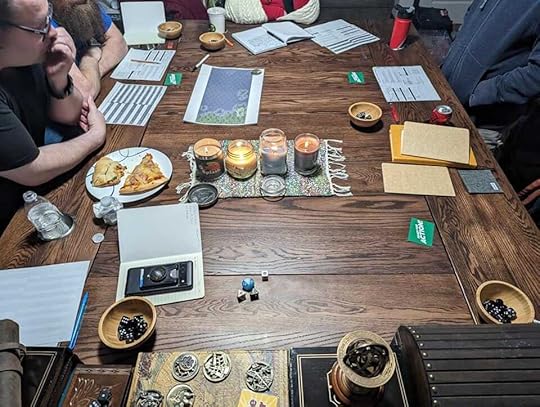
The game does a lot really well. It’s accessible to understand, it’s punchy, deadly, and engaging in all the right places, while ignoring a lot of baggage I’d have cut anyways. It’s well worth the price of admission, just for the inspiring ideas therein, and there hasn’t been a naval/age of sail rpg that’s grabbed me this hard in a while.
Our ship is the HMS Erebus, and they are hunting a French Post Ship The Charlemagne, in order to capture its valuable cargo! It’s a great crew, and I’m excited for future voyages.
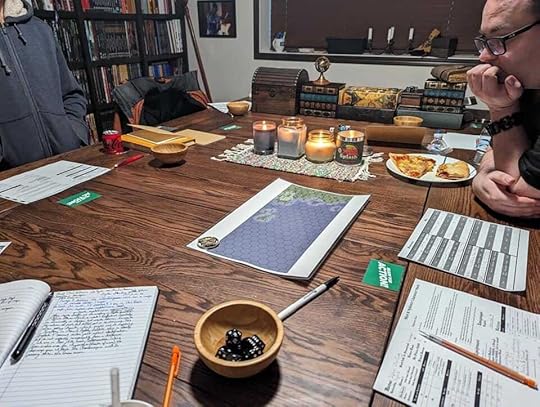
I *really* like this game, and I hope Northern Stranger has more coming for it, so I can really just keep playing long term.
Alan
March 13, 2023
Shadows of a Dying Sun
This is cross-posted from the GKG Patreon, with some tweaks and additions.
Patreons got the PDF of the game if they are pledged at $10 or higher.
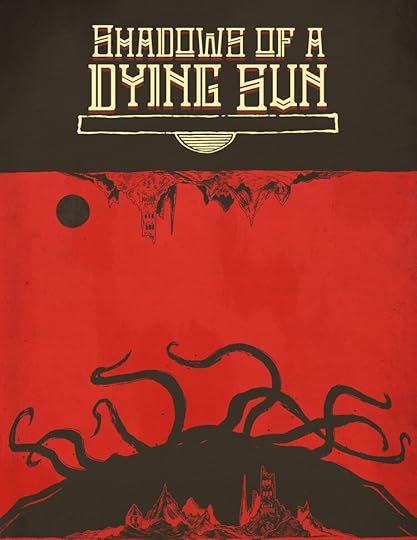
Layout by Robert Denton. Art by Perplexing Ruins.
A MILESTONEShadows of a Dying Sun (SoaDS) is "GKG-100", meaning it's the 100th SKU that we've set up in DTRPG and our system for product identification (this excludes things like the "TinyZines" as they are a GKG-TZ SKU, char sheets, free downloads, etc.)
It's crazy to think how far we've come in under 7 years (we ran our first Kickstarter in Q1 of 2016), and here I am uploading the 100th major product between our product lines.
It's also meaningful to me because SoaDS is the second product I ever began designing with the intention of releasing it. My first draft is from 2014, so nearly ten years old.
Big feels this weekend as I uploaded it.
It’ll be coming to a crowdfundr soon, as we want to print some for retail, but backers will get POD codes and PDFs basically right away. So it’s gonna be a fun and fast project.
HOW DID IT CHANGE?Well, mechanically, it's been through a lot of iterations. Here's some of the various rulesets (roughly in order) I tried working on it with:
- D6^3 (Mayhem - the Planet Mercenary system)
- Savage Worlds
- various OSR engines
- diceless games (this one died fast).
- the "MAIL" system (the current system).
Currently, the only playable characters are humans, but in my original draft, I had notes for things like:
Lanternkin: weird luminescent beings
Morlocks: Underground dwelling beings
Aeonblooded: cosmic travelling weird fantasy beings.
Some of those might make an appearance in a later book, but I elected to really tighten down the focus of the game into a really tight book. I was trying to write a 300 page detailed setting and that's not what I wanted to do as I learned more about the game.
I'm really happy with how the game is now and it fits my vision (that I didn't really know I had) at the time. Maybe one day, I'll get my first game (Gallant) up and moving again. I did name the company after it, after all.
If nothing else, I want this book to stand alone and be well done.
But I have some ideas. We'll see if I decide to pursue them… (small hint below).
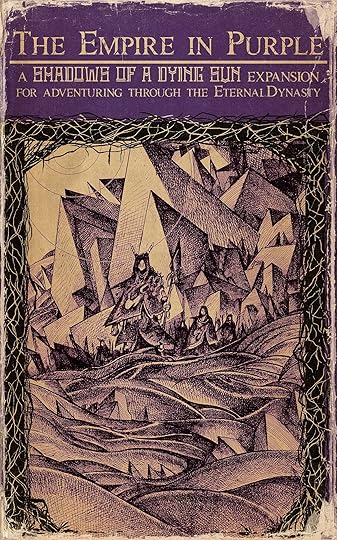
It was interesting to sit back, look at what I’d written nearly ten years ago, and see what I’d written in the last few months or last year. Very different style of thought and approach.
I often feel like I’m exactly where I was ten year ago in my game career, but SoaDS was a nice reminder of exactly how far I’ve come as well. I’m very proud of this game.
See you in the World of the Dying Sun soon.
Alan
February 22, 2023
Radio Free RPG
You might be interested to know that I’ve started a new podcast, where I interview RPG professionals of all talents, and we talk about the behind the scenes, general RPG things, and more! I try to keep them between 30 and 45 minutes, and we just keep it a friendly, welcoming chat!
The first episode dropped yesterday, and the show is called Radio Free RPG. We’re currently on Spotify, Zencastr, and Apple, with Google coming soon (they take a few days to populate). It’ll continue to come out on Tuesdays for the foreseeable future.
It’s a fun way to learn more about the folks I work with, as well as people or things I don’t. The guest in the first episode was the wonderful Amanda Kahl, and I’d love it if you’d give it a listen and give feedback as we continue forward!
The first four episodes are locked and loaded already and more are piling up rapidly as I get my feet under me.
I’ve got a design theory letter coming later this week, but with some life changes, I’m trying to get into a new workflow habit and this substack (and back to blog posts) are part of that!
Talk soon and all that.
February 8, 2023
Legacy Gaming
I've got a Kickstarter up that relates to this topic. Check it out.
Since the “legacy” style board games started coming out years ago, I’ve been fascinated with the idea of “legacy” in board games. If you are unaware, a legacy board game is one where the game state is permanently changed or altered by what happens (via stickers, destruction of game materials, writing, etc.)
I find it a fascinating…well, anything really. But especially as it applies to RPGs.
Of course, character sheets are automatically a sort of “legacy” component, so RPGs already have that vibe.
Other companies have experimented with this. Games like A Single Moment where character sheets can be torn when you die, TORN by Robert Denton, where your character sheet is mutilated as horror movie bits happen to you, Forbidden Lands, with its maps and stickers, all play with elements of that legacy style of play.
To me, the most interesting legacy artifact is one that has a record of your game as well as an in game use.
Imagine keeping a “in-character” journal, that served as a living ongoing representation of the game, as well as an artifact that can be handed down to future characters to bring them up to speed on the game. To me, that idea is *really* cool.
Which is how I ended up on this current four-zine bundle. Rich August (from Steamforged Games) and I were talking about the potential, and I whipped up Montnoir as a brief exercise to get my ideas workable and on paper. We sorta jammed out these games to the point where you see it now on Kickstarter.
I’m pretty thrilled with the idea and I think they came together great. You should check them out.
The idea of a long-term artifact to represent your game really appeals to me, and hits a lot of my buttons lately when it comes to RPGs.
What do you think? What are some aspects of legacy gaming you’d be interested in?
January 30, 2023
Cosmic Horrors & Birthdays
Let’s wait to tell you this one. Tiny Cthulhu is $1 until sometime on 2/1 when I change it. Link here: https://www.drivethrurpg.com/product/332293/Tiny-Cthulhu
So my birthday is tomorrow (or today, depending on when you read this). It’s a bit weird, as it marks me being far closer to a decade in the game industry than not, and two years and change of doing GKG and game design full time.
Thanks for reading Northern Lights Foundry! Subscribe for free to receive new posts and support my work.
I read a lot of philosophy texts, and at this birthday, I’m very close to “halfway” (assuming I will live to the average age of a male in the US, blah blah.) As I’ve gotten older, I’ve often thought about a few particular topics, mostly related to the idea of my place and legacy in the world. I think about the games I make, the people I deal with, and how they feel after interacting with me and GKG/GKG products.
I often think about Bill Watterson (creator of Calvin & Hobbes), and an interview he gave in 2010 to the The Plain Dealer, where he was talking about the 15th anniversary of the end of Calvin and Hobbes (a comic I deeply love and consider a defining philosophical text for me). He said at one point (about ending the strip when he did, under the age of 40):
This isn't as hard to understand as people try to make it. By the end of ten years, I'd said pretty much everything I had come there to say. It's always better to leave the party early. If I had rolled along with the strip's popularity and repeated myself for another five, ten, or twenty years, the people now "grieving" for Calvin and Hobbes would be wishing me dead and cursing newspapers for running tedious, ancient strips like mine instead of acquiring fresher, livelier talent. And I'd be agreeing with them. I think some of the reason Calvin and Hobbes still finds an audience today is because I chose not to run the wheels off it. I've never regretted stopping when I did.
It’s interesting to contemplate, as I’ve grown older in the industry, and seen friends, mentors, and guiding lights to myself pass on, with only the legacy their work and interactions provide to continue standing for who they are and what they meant.
Now this is not to say I intend to quit GKG or stop making games. I deeply love it, and I happen to think I do ok at it. But as I continue forward, I have (as I admittedly always have), a compass point to keep me oriented on the idea of "all my work standing in my stead, after I can’t speak for myself.” Whereas this was a compass point I considered, I find it growing more into a guiding light as GKG and myself move into the future.
The questions I ask when I start a new game are now different than they once were (a realization that took me some time to reach, I admit):
Will I enjoy working on this?
Will those who read it know my passion for this work?
Will my work reflect what I put into it?
Does this work exist as something that I want representing me when I no longer can?
I don’t think every answer must be yes, but I certainly feel stronger about my work when I feel like it can be.
What I’m watching: Royal Rumble (awesome show this weekend), Thunderbolt Fantasy, Harryhausen movies, Red Dwarf, and a bunch of documentaries.
What I’m reading: Some new comics (Over the Top Rope), some new spy novels (waiting before I recommend), and more.
What I’m playing: Spectaculars, Esteren, Sword & Blackpack, and playtests!
What I’m listening to: Lots of Chris Botti, Sting, and Mindi Abair.
Thanks for reading Northern Lights Foundry! Subscribe for free to receive new posts and support my work.
January 20, 2023
Design Theory: Intentional Design
It’s time for another substack newsletter thing! First, announcements. You can get the Tombpunk ashcan on www.tombpunk.games! It’s a living document as we work towards 2.0, so expect it to change, but it’s currently free, so grab it!
Osprey announced my Heirs to Heresy expansion: FAITH & FEAR! Pretty excited about this one.
Intent in DesignQuick note, cuz it’ll come up. I’m not gonna touch on the OGL stuff on this or any future newsletters for the time being. I’ve said my piece previously and until I see final documentation on anything, I’m not interested in adding more to the conversation.
One of the threads I’ve been harping on in my design discussions with my regular creative circles has been intentional design.
Intentional design is a bit of an extension of Dieter Rams’ ten principles of good design. I’m a longtime Rams acolyte. I consider him my guiding polestar for my design ethos, especially if we don’t include anyone in the industry). Intentional design is a natural place for me to continue exploring my design space.
Intentional Design is the concept of keeping each touchpoint in your game considerate of the final user (the reader/player/GM). This means instilling a deliberate design ethos in your product that is designed to facilitate five major goals.
Obviously this is my view on one design philosophy, and how it applies to gaming. This doesn’t work for everyone and I don’t expect it would. But it works for me.
1.) Radical SimplificationIn my eyes, this is keeping the product as simple as possible, while still providing the full experience. “Less, but Better”, as Dieter Rams would say.
Does a rule/text/art enhance the experience the game is intended to provide? If no, it needs to go.
This also applies to how I’ve started approaching our crowdfundings. Things like bags, dice, etc. can often over complicate the experience, instead of enhancing it, and I’m trying to make more deliberate choices in what we include as accessories. These tactile bits can be really useful and enhance a game (I buy enough of these sorta things to really love them and understand their value), but they can also detract if poorly handled (or if they delay a product).
2.) Deep UnderstandingWhat does this mean? For me and how I view games, this goes back to Rams’ fourth rule of good design: “make a product understandable”. The end goal is for the game to clearly communicate, portray, and be easily understandable on how it is intended to be used.
As an example, let’s consider hex crawls and setting books. Sometimes I’ll crack a city book and not really know what I’m supposed to do with it, but a hex-crawl is almost always very clear on how I’m intended to utilize that. Now that’s a drawback of the communication medium: it is easy for a hex-crawl to communicate how you’re supposed to use it, as how it is used is an implicitly understood element for many gamers.
So how do we make text heavy RPG products more understandable and useable?
This includes things like sidebars, clarifying text, and extends to things like form-factor (landscape versus portrait, text choices and more).
Some things I’ve done towards this in the past (some unintentionally of course. I’m always learning and growing):
Designer Commentary sidebars (Eorathril had this, and I’ve replicated similar features later on.)
Clear communication of the game and its goals in the text (Heirs to Heresy, Crescendo of Violence.)
Reader friendly font choices over more artistic ones for essential text.
This isn’t to condemn artistic choices for fonts. I love them, and use them myself when I’m doing layout. I just try to be conscious of the fact that essential text needs to be easy to parse and understand when reading it.
We’ve recently been exploring options for dyslexic friendly fonts, as well as other options.
3.) Extreme FocusThis is related to line one when it comes to game design. The game (in my opinion) should be very tightly focused on the core goal it is trying to fulfill. Pendragon does a great job of this. Every rule in that game is about being a knight. Nothing in that game is extra or outside of that core goal.
This one is really hard for me to hit. I often like adding bits and bobs that I think are cool and make the experience better, but recently I’ve been trying to hold myself back in those regards.
4.) Personal ConnectionGames can often feel sterile, manual-like, or dry. With intentional design, we try to focus on connecting the artists behind the game with the end-user of the game. The writing should feel personal and passionate, the art should feel like it connects with the end-user and with the game.
This is a hard, subtle, unclear one, but it’s important to keep in mind.
5.) Direct CommunicationSimilar to 2, Direct Communication is about making the user feel confident, comfortable, and empowered to use the RPG product. People feel good when they feel like they can achieve the aims. Daunting or overwhelming products inhibit the user experience, and this is one place playtesting and reviews from opinions that differ from your own can help clear up the miasma of our own blind spots.
A great video on Intentional Design (courtesy of Apple and their developer conference)
I think when we include all five of these (in conjunction with Rams’ work), it can really improve our approach to game design. I know constantly reconsidering these elements has made me a far better publisher and mechanical designer than I used to be, and as I revisit them, I grow excited for my future as a game publisher and designer.
Current Inspirations
What am I reading? I just finished rereading The Prophet by Kahlil Gibran, and I’ve got a long list of other philosophy texts to dig into, but first I’m gonna finish reading the new Elric novel.
What am I listening to? Lots of science fiction soundtracks, mostly video games (Destiny, Anthem, etc.) Lots of ambient stuff, as well as some synth Robert Denton turned me onto.
What am I playing? In RPGs, Shadows of Esteren, playtest games, some solo RPGs (Sacrifice, a few of my own), and a few card games (Flesh & Blood, Supershow).
What am I watching? Been on a Swords & Sandals kick, with the classic Harryhausen Sinbads and Jason and the Argonauts. Probably what inspired Swords of Meropis after all.
January 11, 2023
Giveaway, OGL 1.1, Musings
Woo! Let’s celebrate this newsletter thingy with a book give away! I’ll be giving away two signed books: a copy of Heirs to Heresy and a copy of Crescendo of Violence! Both were releases from Osprey Games and some of my favorite work I’ve done! All you need to do to get a copy is be subscribed to this newsletter by January, 31st!
The winners and the game they get will be randomly selected (though if you already have one, I’ll make a swap).
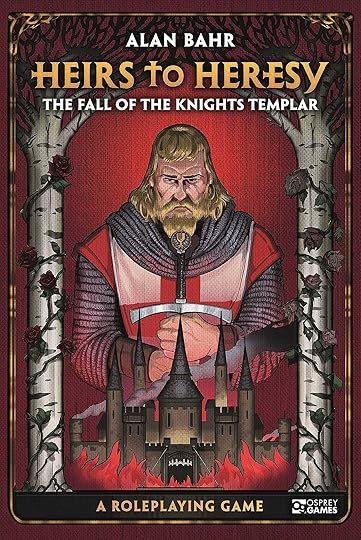
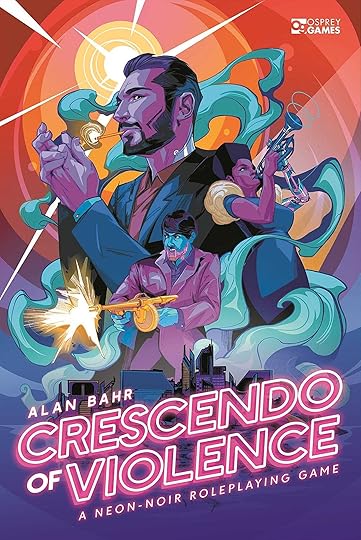 OGL 1.1?
OGL 1.1?The RPG industry is currently in an uproar due to rumored leaks about the plans Wizards of the Coast has for the future of the Open Gaming License. My friend Lance, from Undead Viking came over and interviewed me about my thoughts and feedback.
You can see that here. It’s mostly a bunch of “I am not a lawyer, and I haven’t seen any paperwork, so I don’t know.” But hey, maybe it’ll help, maybe it won’t.
Work/Playing GamesI’ve been running Shadows of Esteren, Traveller, some playtesting games, and playing a lot of the Supershow card game. I’m also writing more than I ever have in my life, chewing through nearly 10k words a day, and having a blast doing it. I’m feeling very much at a peak creatively, doing what I consider some of my best work and that is a lot of fun to be in the zone for.
Stuff you can expect from me?
The awesome Rick Hershey and I are going to team up to do some cool ‘small-form’ RPGs (digest sized, hardcover), published through GKG and similar to SYMA, but created collaboratively.
A bunch of long-delayed (2020 is the gift that will give forever it seems) projects will be coming out this year too. I’m feeling productive and busy, but in that good, enjoyable “I love this” way I’ve really been missing the last few years.
It’s nice to “be back”.
Thanks for reading Northern Lights Foundry! Subscribe for free to receive new posts and support my work.
January 9, 2023
A brand new...old thing, new again?
Well hey. It’s me. Alan. The guy who does stuff at Gallant Knight Games, and other places as Northern Lights Foundry. I don’t have a personal mailing list and while I have a blog, I thought this substack thing might be a good try.
I intend the NLF dispatches to be complimentary to my posting and work at www.alanbahr.net, likely doubled up at times, sometimes not. I’m not particularly trying to spread myself around, but managing multiple mailing lists is a lot of work, and I already manage too many.
I’m hoping this will make it easier somehow.
How? I don’t know. I just kinda like trying new things.
Northern Lights Foundry is the personal imprint where I do work and media production for companies outside of Gallant Knight Games. It includes games, podcasts, and more.
I write a lot of games and I can’t always publish all my work at GKG, so Northern Lights Foundry is how I get the rest out. I partner with other publishers and studios to create works (my own) or as a freelancer for them.
So what can you expect? Well
news about my upcoming releases from Osprey Games
Tombpunk news
projects I work on in a freelance capacity
my upcoming work in comics
podcasting (Rich August and I have a non-RPG-centric podcast being recorded now, and there’s at least one more RPG-centric podcast coming)
little bits of GKG news
musings on RPGs and other media/culture
probably some philosophy and poetry (I’ve found the mental capacity to dig back into those loves of mine, and it’s been wonderful)
and more probably.
I don’t know how frequently I’ll use this. Maybe weekly. Maybe daily (that seems unlikely knowing me), but you can expect at least something semi-regularly. I need to get back in the habit of writing and this is part of that effort.
See you down the road.
Alan
Thanks for reading Northern Lights Foundry! Subscribe for free to receive new posts and support my work.



